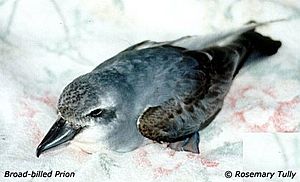Broad-billed prion facts for kids
Quick facts for kids Broad-billed prion |
|
|---|---|
 |
|
| Conservation status | |
| Scientific classification | |
| Genus: |
Pachyptila
|
| Species: |
vittata
|
| Synonyms | |
|
Prion vittatus (Forster, 1777) |
|
The broad-billed prion (Pachyptila vittata) is a small seabird that lives in the ocean. It is the largest type of prion. This bird has grey feathers on its upper body and white feathers underneath. People have called it by many other names, like blue-billed dove-petrel or whalebird.
Contents
About Prions
The broad-billed prion belongs to a group of birds called Pachyptila, which are also known as prions. These birds are part of a larger group called Procellariidae (petrels and shearwaters), and they all belong to the order Procellariiformes.
Prions are small birds that mostly eat tiny ocean creatures called zooplankton. All birds in the Procellariiformes group share some special features:
- They have unique nostrils on top of their upper beak, called naricorns.
- Their beaks are made of several horny plates, usually seven to nine.
- They can make a special "stomach oil" from wax esters and triglycerides. They store this oil in a part of their stomach. They can spray it out to defend themselves from predators. This oil is also a rich food source for their chicks and for adult birds during long flights.
- They have a salt gland above their nasal passage. This gland helps them remove extra salt from their bodies because they drink a lot of ocean water. They get rid of the salty liquid through their nose.
What's in a Name?
The name Pachyptila comes from ancient Greek words. Pakhus means "thick" or "stout," and ptilon means "a feather."
The word prion also comes from Greek, from the word priōn, which means "a saw." This name refers to the saw-like edges on the bird's bill. These edges help the bird filter food from the water.
How to Spot Them
The broad-billed prion has typical prion colors: blue-grey on its upper parts and white underneath. It also has a distinct "M" shape across its back and wings. It has a black crown (the top of its head), a dark stripe near its eyes, and a black tip on its tail. Its bill is black too.
This bird has a wide, flat bill with comb-like fringes called lamellae. These fringes act like a filter. The broad-billed prion is a large prion, measuring about 25 to 30 centimeters (10 to 12 inches) long. Its wings can spread from 57 to 66 centimeters (22 to 26 inches) wide. On average, it weighs between 160 and 235 grams (5.6 to 8.3 ounces).
Bird Behavior
Broad-billed prions are social birds. However, they usually do their courtship displays at night or inside their burrows. If their nests are threatened, they can be very aggressive. They will call loudly, posture, and even bite necks to defend their homes.
How They Find Food
These birds are gregarious, meaning they like to be in groups. They eat crustaceans (like tiny copepods), squid, and small fish. They have a special way of eating called hydroplaning. This is when the bird flies with its bill in the water, skimming the surface to scoop in water. Then, it uses its bill to filter out the food. They also grab food right off the water's surface. Unlike some other seabirds, broad-billed prions do not usually follow fishing boats.
Reproduction and Life Cycle
Broad-billed prions start their breeding season in July or August. They build their nests in burrows on coastal slopes, lava fields, or cliffs of islands. The female lays just one egg. Both parents take turns incubating the egg for about 50 days. After the chick hatches, they spend another 50 days raising it.
The main predators for these birds are skuas. On some islands, cats and rats have also caused a big drop in the number of prions. After December, the bird colonies usually spread out. However, some adult birds stay near the breeding islands and might visit their burrows even in winter.
Where They Live
You can find broad-billed prions in oceans and along the coasts of the Southern Hemisphere. Their colonies (large groups of breeding birds) are located on islands like Gough Island, Tristan da Cunha, and islands off the coast of New Zealand, including the South Island, Chatham Islands, and the subantarctic Antipodes Islands.
Looking After Prions
The broad-billed prion lives across a very large area, about 10.5 million square kilometers (4 million square miles). Scientists estimate that there are around 15 million of these birds. Because their population is so large and widespread, the IUCN considers them a species of least concern. This means they are not currently at high risk of extinction.
See also
 In Spanish: Pato petrel piquiancho para niños
In Spanish: Pato petrel piquiancho para niños


